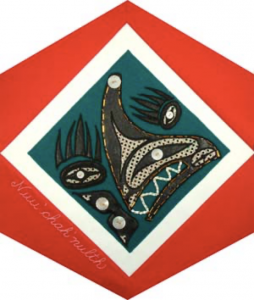Nuu’chah’nulth

The Block
Josee Watts, of the Nuu’chah’nulth First Nation, stitched and beaded this block, which depicts her family crest. The crest, on a forest-green background, shows the transformation of a bear into a whale, both of which were designed by Josee’s artist and carver son, Tobias (Bear) Watts. The theme of transformation speaks to the beauty of Josee’s rediscovered and revitalized cultural heritage, as well as to personal growth and change.
Cultural Profile
The Nuu’chah’nulth are an ancient coastal society, dating back 10,000 years or more. Originally there was no name for the Nuu’chah’nulth language, which is part of the Wakashan linguistic family, or the people who spoke it. The term was decided upon by the West Coast Allied Tribes in 1978 to refer to all the sub-groups that spoke the language. The Nuu’chah’nulth Tribal Council now represents 14 distinct Nuu’chah’nulth First Nations. The name “Nuu’chah’nulth” translates roughly to mean “along the mountains” and refers to their traditional territory.
The Nuu’chah’nulth groups flourished on the abundant natural resources of their environment along the west coast of Vancouver Island, stretching from Brooks Peninsula to Port Alberni Inlet to Sheringham Point. Life was sustained by the vast quantities of fish, such as herring, salmon and steelhead, that was available in the ocean and island rivers. Today the devastated fish population is cause for great concern.
The Nuu’chah’nulth were the only Northwest Coast tribe that hunted whales. Their dugout canoes were built specifically to handle rough ocean waters and to tow the heavy mammals back to their villages along the beach. The sturdy vessels were constructed from cedar trees (the “tree of life”), which grew in abundance in the temperate rainforests. These trees were considered a gift from the Creator and were therefore treated with great respect. The people used cedar wood to make nearly everything; from paddles and masks, to building houses, while the bark was especially useful for making clothing, weaving baskets and twining into rope.
The Nuu’chah’nulth still make a traditional dessert using the sour red berries of Soapberry (Camus) shrubs. Equal amounts of soapberries and water are placed in a clean glass with a spoonful of sugar, then whipped into a light foamy texture, soft pink in colour.
Sponsor: Dr. Betty Martin, May Winslow & Bill Martin, in memoriam Jane Maria Houston-Carson, their grandmother
